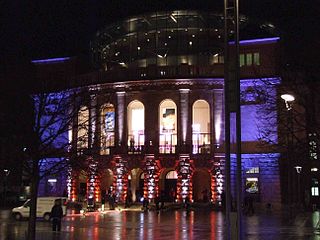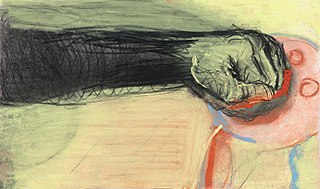Related Research Articles

Goslar is a historic town in Lower Saxony, Germany. It is the administrative centre of the district of Goslar and is located on the northwestern slopes of the Harz mountain range. The Old Town of Goslar with over 1.500 timber houses and the Mines of Rammelsberg are UNESCO World Heritage Sites for their millennium-long testimony to the history of ore mining and their political importance for the Holy Roman Empire and Hanseatic League. Each year Goslar awards the Kaiserring to an international artist, called the "Nobel Prize" of the art world.
The Roswitha Prize is the oldest German language prize for literature that is given solely to women.

Olafur Eliasson is an Icelandic–Danish artist known for sculptured and large-scaled installation art employing elemental materials such as light, water, and air temperature to enhance the viewer's experience.

The Carl Zuckmayer Medal is a literary prize given by the state of Rhineland-Palatinate in memory of Carl Zuckmayer. The medal itself was fashioned by state artist Otto Kallenbach. The prize is also given with a 30-liter cask of Nackenheimer wine from the Weingut Gunderloch, a winery valued by Zuckmayer. The bestowal takes place on 18 January, the anniversary of Zuckmayer's death.
Katharina Fritsch is a German sculptor. She lives and works in Düsseldorf, Germany.

The Upper Harz Water Regale is a system of dams, reservoirs, ditches and other structures, much of which was built from the 16th to 19th centuries to divert and store the water that drove the water wheels of the mines in the Upper Harz region of Germany. The term regale, here, refers to the granting of royal privileges or rights in this case to permit the use of water for mining operations in the Harz mountains of Germany.

The Imperial Palace of Goslar is a historical building complex at the foot of the Rammelsberg hill in the south of the town of Goslar north of the Harz mountains, central Germany. It covers an area of about 340 by 180 metres. The palace grounds originally included the Kaiserhaus, the old collegiate church of St. Simon and St. Jude, the palace chapel of St. Ulrich and the Church of Our Lady (Liebfrauenkirche). The Kaiserhaus, which has been extensively restored in the late 19th century, was a favourite imperial residence, especially for the Salian emperors. As early as the 11th century, the buildings of the imperial palace had already so impressed the chronicler Lambert of Hersfeld that he described it as the "most famous residence in the empire". Since 1992, the palace site, together with the Goslar's Old Town and the Rammelsberg has been a UNESCO World Heritage Site because of its millennium-long association with mining and testimony to the exchange and advancement of mining technology throughout history.
Clemens-Brentano-Preis of the city of Heidelberg is a literary prize of Germany. It was established in 1993, and named after the German poet Clemens Brentano (1778–1842). The prize money is €10,000.
Thomas Mann Prize is a literary prize of Germany. In full the title is "Thomas Mann Prize of the city of Lübeck and the Bavarian Academy of Fine Arts". It is given in alternate years in Lübeck and in Munich. The award is the product of a merger of two prizes in 2010, the Thomas Mann Preis der Hansestadt Lübeck and the Großer Literaturpreis of the Bavarian Academy of Fine Arts. The Thomas Mann Prize Lübeck was first awarded in 1975; the Great Literature Prize was first awarded in 1950. The prize money is €25,000.

Miriam Cahn is a Swiss painter.
The Brahms-Preis has been awarded by the Brahms Society of Schleswig-Holstein since 1988. The prize is furnished with 10,000 euros. It rewards artists who have contributed mesmerizing work for the preservation of the artistic heritage of Johannes Brahms.
The Heimito von Doderer-Literaturpreis was established in 1996 to commemorate the 100th birthday of Heimito von Doderer. It was created as a memorial to "one of the most important writers of the 20th century", and to honor a single work or life work of a contemporary writer who excels in "language of high sensitivity and originality in the tradition of Doderer.

The Käthe Kollwitz Prize is a German art award named after artist Käthe Kollwitz.

Peter Welz is a contemporary German artist based in Berlin. He has been exhibiting his work in video, sculpture and installations since 2003.
The City of Leipzig awards the Leipzig Book Award for European Understanding which has been given since 1994. The award is endowed with prize money of 20,000 Euro and is presented every year during the official opening of Leipzig Book Fair.
Tillmann Lohse is a German author, editor, academic, and scholar of Medieval History. In 2003 he was honoured with the "Goslarer Geschichtspreis" for his research on the Salian emperor Henry III. In 2009 he obtained his doctoral degree from Humboldt-University of Berlin. His dissertation dealt with the collegiate church SS. Simon and Jude in Goslar whose manuscripts and files have been stored in various German and Austrian archives since its secularization at the beginning of the 19th century. From these sources Lohse edited a 12th-century urbarium, a 13th-century chronicle and a 15th-century ordinal, all of which were once composed by members of the chapter. Besides pious endowments Lohse's research focusses mainly on the history of migrations, especially the ones of missionaries, and mercenaries, as well as on digital diplomatics. During the spring term of 2017 Lohse was guest professor at Goethe University Frankfurt, since fall 2017 he teaches as an associate professor at Humboldt. In 2021 he was awarded a prize for promoting democracy by Stendal district administrator Patrick Puhlmann.

Wiebke Siem is a German mixed media artist of German and Polish heritage, winner of the prestigious Goslarer Kaiserring in 2014 as "one of the most innovative and original artists who has never compromised in their art and whose sculptures have a tremendous aura and presence because they mix the familiar and the unfamiliar, the known and the unknown".
Andreas Greiner is a German artist, based in Berlin. He works with a wide range of different media including sculpture, installation, photography, video and techniques such as electron microscopy, algorithmic image creation and 3D printing. Frequently he works with biological and natural growth processes to create art works. His approach addresses humanity’s relationship with its living and non-living environment and the nature–culture dichotomy.
The Schiller Prize of the City of Marbach, endowed with 10,000 euros, is awarded every two years on 10 November, Friedrich Schiller's birthday, to personalities who are committed to the poet's tradition of thought in their life or work. The prize was first awarded in 1959, on the 200th birthday of Schiller. Up until 2007 it was awarded every two years for outstanding work in the field of regional studies of Württemberg. In the Schiller Year 2009, the award criteria were changed. The award has been given to persons who are committed in their life or work to Schiller's tradition of thought.
The Karl Valentin Order was established by the Carnival club Munich Society Narrhalla e.V. on the occasion of its 80th anniversary. It was awarded for the first time in 1973. The Karl Valentin Order commemorates the legendary Bavarian humorist Karl Valentin (1882–1948). According to the foundation's protocol, the medal is awarded to a personality from art, politics, science, literature or sport for a humorous and profound comment or deed, for extraordinary work as an artist or to an outstanding figure in public life. The award ceremony takes place at the beginning of each year as part of the Narrhalla Soirée in the Deutsches Theater Munich.
References
- ↑ "Kaiserring". Mönchehaus Museum Goslar (in German). 18 July 2013. Retrieved 16 July 2021.
- ↑ "Kulturpreise.de : Kaiserring der Stadt Goslar". Handbuch der Kulturpreise – Handbook of Cultural Awards (in German). Retrieved 16 July 2021.
- ↑ "Modern Art and the Kaiserring Award". World Heritage Journeys of Europe. Retrieved 16 July 2021.
- 1 2 3 Kühn, Karin (2021). "Kaiserring". GOSLAR am Harz, UNESCO-Weltkulturerbe (in German). Retrieved 16 July 2021.
- ↑ "Liste der Kaiserringträger". Mönchehaus Museum Goslar (in German). 18 July 2013. Retrieved 16 July 2021.
- ↑ "Olafur Eliasson geehrt als Künstler auf den Spuren da Vincis". ZEIT ONLINE (in German). Retrieved 16 July 2021.
- ↑ "Goslarer Kaiserring – www.kunstforum.de". www.kunstforum.de (in German). 16 July 2018. Retrieved 16 July 2021.
- ↑ "Goslarer Kaiserring: Preisverleihung wird auf 2021 verschoben". GT – Göttinger Tageblatt (in German). 17 September 2020. Retrieved 16 July 2021.
- ↑ Sturde, Nina (2021). "Wer bekommt den Goslarer Kaiserring 2021?". GOSLAR am Harz, UNESCO-Weltkulturerbe (in German). Retrieved 16 July 2021.
- ↑ "US-Konzeptkünstlerin Adrian Piper bekommt Goslarer Kaiserring 2021". Monopol (in German). 21 January 2021. Retrieved 16 July 2021.
- ↑ "US-Konzeptkünstlerin Piper bekommt Goslarer Kaiserring 2021". ZEIT ONLINE (in German). Retrieved 16 July 2021.
- ↑ "Goslarer Kaiserring 2022 geht an Isaac Julien". stern.de (in German). 1 February 2022. Retrieved 2 February 2022.
- ↑ "Konzeptkünstler mit Goslarer Kaiserring ausgezeichnet". NDR.de (in German). 7 October 2023. Retrieved 7 October 2023.
- ↑ "Goslarer Kaiserring 2024 geht an Künstlerin Miriam Cahn" [Goslar Kaiserring 2024 goes to artist Miriam Cahn]. Tagesschau (German TV programme) . 12 January 2024. Retrieved 12 January 2024.
- ↑ "Auszeichnung: Miriam Cahn erhält Kaiserring der Stadt Goslar". Die Zeit (in German). 12 January 2024. Retrieved 12 January 2024.
- ↑ "Goslarer Kaiserring 2025 geht an Bildhauerin Katharina Fritsch". Monopol (in German). dpa. 11 January 2025. Retrieved 11 January 2025.